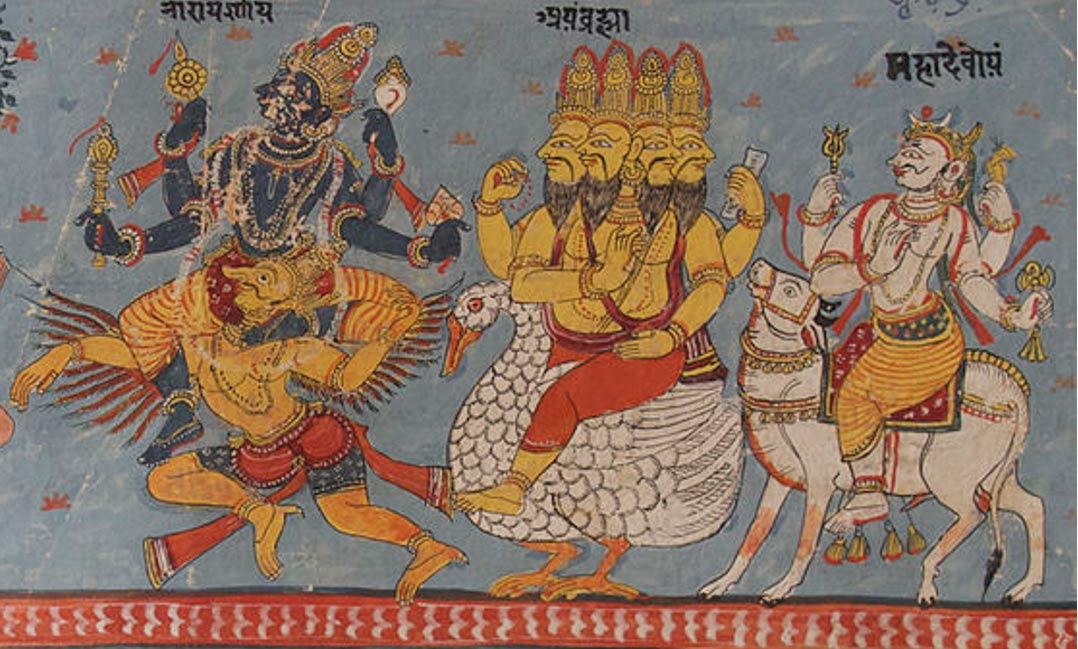The Anu and Ancient Seers in the Rig Veda
The oldest of the Vedas, a large body of ancient literature and scriptures of Hinduism, the Rigveda contains poetic and mythological origin stories involving gods and their descendants.
In Hindu mythology, Angiras are celestial beings and descendants of gods, who watch over humans and protect sacrificial fires. The Angirasas are among the oldest families of Rishis (Seers) in the Rigveda. In this text, Agni, god of fire, is sometimes referred to as Angiras.

Rigveda manuscript in Sanskrit on paper, India, early 19th century. Public Domain
The supreme deity of the Sumerian pantheon is AN, or Anu. In the first two letters of the Sanskrit word An-gir-as, AN could refer to Anu. GIR might relate to the Akkadian fire-god— fire as in rocket propulsion. DinGIR in the cuneiform writing meant sky or heaven, and also a god or goddess. The masters of the sky were perceived as deities by the earthbound. This reminds of Angiras and his descendants, the Angirasas, as a group of higher beings who traversed the realms between gods and men — an inter-stellar and inter-dimensional elite.

Agni, god of fire, shown riding a goat in a miniature painting from an 18th century watercolor. Public Domain
The seven Rishis are identified with the seven stars of the Big Dipper. Their wives are the six stars of the Pleiades (Krittikas), plus one visible double star of the Big Dipper. Originally these seven Rishis, sapta vipra, were identified as Angirasas.
[David Frawley]
MORE
- Colony Earth: Science in The Vedas - Part 1
- Did the mythical Saraswati river of the ancient Vedas really exist?
- 10,000-year-old rock paintings depict UFOs and extra-terrestrials, claims archaeologist
The Angirasas and the Bhrigus families "...represent the pre-Rig Vedic past: they go so far back into the past that not only are they eponymous founders of these families (Angiras and Bhrigu respectively), but even certain other ancient Rishis belonging to these families (Brihaspati, Atharvan, Ushana) are already remote mythical persons in the Rigveda; and the names of the two families are already names for mythical and ritual classes: the Angirasas are deified as 'a race of higher beings between Gods and men' ...the Bhrigus and the Atharvans are synonymous with fire-priests in general. ...the names of these two families are also found in the Iranian and Greek texts..." [Shrikant G. Talageri]

A Hermit (Rishi), India was an inspired poet of Ṛegvedic hymns. They were responsible for tending sacrificial fires and were said to invoke gods with poetry. 11th century AD, pink sandstone. Public Domain
No one can compare the Avestan poetry with the Indian [Rigvedic] poetry in its content, in its style of expression, and in its entire coloring, without coming to the conclusion, on account of their agreement in small details which force themselves on us at every step, that both the literatures point not only to a common origin of these two peoples and their religions, but also to a community of Indo-Iranian religious poetry, developed in well-established forms.
[Hermann Oldenberg]
"The name Anu or Ânava for the Iranians appears to have survived even in later times: the country and the people in the very heart of Avesta land, to the immediate north of Hâmûn-i Hilmand, were known as late as Greek times as the Anauon or Anauoi. The names of Anu tribes in the Rigveda and the Puranas can be clearly identified with the names of the most prominent tribes among latter-day Iranians." [Shrikant G. Talageri]
MORE
- Speakers at Science Congress says ancient India mastered advanced space flight thousands of years ago
- Who the ETs are & What is up there on our Moon? Part I
- Jauhar - The History of Collective Self Immolation during War in India
Malati J. Shendge says "Sanskrit is derived from Akkadian and Sumerian...Sanskrit is not a language of the Aryas...It is essentially a lineal descendent of the languages of the Asuras." She states that the Rig Veda does not belong to the Aryas and in fact in her view this was "purely an assumption without any firm basis." And she states "...it is possible to find parallels in the Akkadian sources to many clans and personal names of the poets of Rig Vedic compositions, and of the Asuras, the enemies of Indra." She believes that the language of the Rig Veda — [meaning the older Vedic Sanskrit which is very different from the latter classical Sanskrit] — is a form of Akkadian and "that the Akkadian in the process of evolution has become what we know today as Sanskrit."
You can read the full detailed article on the topic at Susan’s website here.
Featured image: A page of a Bhagavata Purana illustrated manuscript in Devanagari. Illustration depicts Vishnu, Brahma and Shiva seated on their respective vahanas. Public Domain
References
Prolegomena on Metre and Textual History of the Rigveda, by Hermann Oldenberg, Berlin 1888; translated into English by V.G. Paranjape and M.A. Mehendale; Motilal Banarsidass Publishers Private Ltd., Delhi, 2005.
The Rig Veda and the History of India, by David Frawley; Aditya Prakashan, New Delhi, 2001, 2003.
The RIGVEDA, A Historical Analysis, by Shrikant G. Talageri; Aditya Prakashan, New Delhi, 2000, 2004.
The Civilized Demons: The Harappans in Rigveda, by Malati J. Shendge; Abhinav Publications, New Delhi, 1977.
The Language of the Harappans: From Akkadian to Sanskrit, by Malati J. Shendge; Abhinav Publications, New Delhi, 1997.


















Comments
There is a timing confusion in Hindu history. Some of the real story is as follows. Ramayana was ended around 100,000 years ago as the Rama Civilization left Planet Earth to Mizar Star System due to the fact that Earth was heading for a serious ice age. The only thought here is from the people who came back in reincarnation and remember bits and pieces accompanied from ancestors in the spirit realm. The timing is important.
Then life went on, some people in Europe and India were available later as ice receded. This is 12,000 years ago when Lord Krishna came to being in Dwaraka.. You can google this. At this time the same gentlemen who was alive during Ramayana time was also living in Dwaraka.. Thi s time he remembers some items.
The vedas happened just after Lord Krishna space ship left Dwaraka. So, real short history starts from 12,000 years and Mahabharata. Any idea about Ramayana is collected from the rishis as the information. Here is the catch.. Those who were connected to Heaven, could collect past history very well. So, Ramayana was a collection of data.
But Mahabharata was direct information as then we had Sanskrit and written documents.
We need to get these timing correct. Oh...as to Ramayana, the two way to get the data are: 1) direct information from Heaven. 2) Direct history from the living Ramayana people who watch over us now, from the UFOs. They are told to look like Nordic people in UFO parlance, since they show up in Europe and USA.
It is a complicated history of our past, but we can connect and get the actual data.
The bulk of the Rig Veda was compiled between 1650 BC and 1380 BC - this tallies perfectly with all mainstream theories.
There is no need to revise any dates.
Yet, all aspects of Indian culture can be explained logically and wonderfully.
Read my papers with the maps
https://www.researchgate.net/profile/Sujay_Rao_Mandavilli/contributions
STOP HINDUTVA REVISION OF HISTORY NOW!
Sujay Rao Mandavilli
Anunnaki = 'sons of Anu'
Sri Krishna says ... of Vedas I am the Sama Veda.
Thank you AO for changing the title and getting the "myth" out of the wisdom knowledge of the Rig Veda!
I did not title this article as is posted here on AO. First of all, the Rig Veda is not mythology. The Rig Veda is history, metaphysics, sublime poetry describing many other diverse topics. But definitely not mythology!
Angiras and Atharvan are not myths, but actual men who were Seers - the Rishis, and had large families that followed in their tradition. They were two of the many authors of the Rig Veda and the Atharva Veda. Myths don't write sacred texts.
The Anu people are also not Hindu mythology, but rather an actual tribal group of people as the article clearly states.
Also the header image used of Brahma, Vishnu & Shiva is from a much later text. The Bhagavata Purana is a Vishnu-Krishna text dated from the middle ages. The three deities depicted are barely mentioned in the Rig Veda which is possibly 10,000 years old.
Thank you.